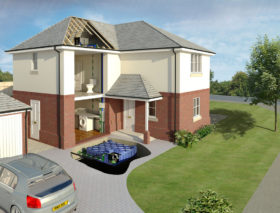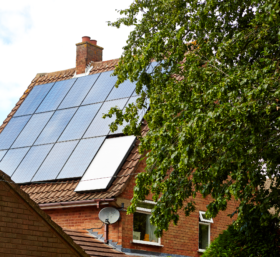
Learn from the experts with our online training course!
Use the code BUILD for 20% off
Learn from the experts with our online training course!
Use the code BUILD for 20% offGreen technologies to generate electricity and heat are making it into the mainstream. To quote just one example, there are more than 80,000 solar water heating installations in the UK and the number is rising every day. Interest in wind turbines is soaring, too. However, there is little point having state-of-the-art microgeneration equipment in your home unless you have got the basics right. This means:
The UK-wide network of local energy advice centres is available on 0800 512 012 and can advise householders on all these steps. You should also use A-rated appliances, especially your fridge, freezer and washing machine. Once you have these steps completed, or specified into your plans, you can start to think about microgeneration. Microgeneration technologies will usually fall into one of two categories: generation of electricity or generation of heat (either for water heating alone or for space and water heating. But there are also microgeneration technologies available that are capable of generating both heat and electricity.
In solar panel water heating systems, water is pumped through a solar panel, which is normally mounted on a roof. The panel uses radiation from sunlight to heat the water that passes through it. From the solar collector the hot water flows to a hot water cylinder that stores the hot water ready for use at the property’s hot taps.
The UK only gets 30 per cent less solar radiation than southern Spain, so there is plenty of energy available to be harnessed in normal bright daylight, even when it is chilly outside or the weather looks miserable. Over the course of a year, a solar water heating system can provide between half and three quarters of a household’s hot water requirements.
Cost: From around £800 for a very basic system to £2,500 for a high quality model for a family home. Savings will be dependent on how much hot water you actually use.
A ground source heat pump consists of two coils of tubing buried in the ground at a depth of around 1m, where the temperature is a fairly constant 7ºC to13ºC. The longer coil contains a mixture of water and anti-freeze, which picks up warmth from the ground. The smaller coil contains a cold refrigerant liquid. The temperature difference between the two coils is ‘magnified’ by a compressor and turned into useful warmth for space and water heating.
Running the compressor requires electricity but a ground source heat pump produces more heat energy than the electrical energy needed to power it. The length of coil required is complex calculation, but a rule of thumb is 10m per kW.
Cost: This will be dependent on how much energy you want the pump to produce. You might pay as little as £1,000 but for a family home’s energy needs, expect to pay £4,000-£5,000 for a first class system.
A wind generator turns by the force of the wind and generates electricity. Small domestic wind generators can be mounted on to a wall or roof and simply plugged into a normal 13 amp socket to provide electricity to the house. Other systems can be used to charge batteries or connect to the National Grid and these systems vary from small roof- or wall-mounted generators to larger stand-alone mast-mounted systems that can generate more substantial amounts of electricity for consumers with big enough land and a high enough average wind speed.
A 2m rotor diameter turbine, for example, would require an annual mean wind speed of between 5.5 and 6m/s to generated a third of the average UK household electricity demand. In most urban areas annual mean wind speed lie between 3 and 5m/s.
With grid connected systems, it is possible to sell any excess electricity generated to the grid but this may involve changing electricity supplier to obtain the best deal available. The government also pays small generators for the electricity they produce, although a special meter will be required for this and the cost of the meter may outweigh the benefits. Small scale turbines tend to have a low output and it is likely that this will be taken by demand from refrigerators and freezers, so little will be available for export.
Cost: From around £2,000 for a small domestic roofmounted turbine up to about £20,000 for a large mast-mounted turbine.
As a tree grows it sequesters carbon dioxide, therefore as long as wood fuel is obtained from a sustainable source and is not transported over large distances, burning wood for heat is a ‘carbon neutral’ activity. Wood-fuelled central heating boilers can provide space and water heating and this equipment is especially suitable if you have your own supply of fuel, for example, logs or trimmings.
Wood chip or log burning boilers tend to be most suitable for large properties with five or more bedrooms. However, smaller heaters that burn wood pellets are available and these systems can be used as stand-alone room heaters or as part of a back-boiler central heating system for smaller properties. Most wood chip or pellet systems have a hopper with an auto-feed and so they are no less convenient than an oil or LPG fi red central heating system.
Cost: From around £4,000 for a 15kW boiler to about £9,000 for a 75kW boiler.
A photovoltaic solar electricity array (or PV system) generates electricity from photovoltaic cells or panels, usually mounted on the roof. These systems use semiconductor technology to generate electric current from the sun’s energy. Solar arrays are rated in kWp (Kilowattpeak) which is the maximum amount of power the system can generate under test conditions at noon on a sunny day. An 8m² photovoltaic array can generate around 800kW per year, just over one-seventh of the amount of electricity used by an average household.
Cost: £12 000 – £14,000 for a 2kWp system for a house.
Hydro power technology turns the potential – or kinetic – energy of water into energy by means of a turbine. Turbines either use water ‘dropped’ from behind a dam or from the natural ‘run of the river’ with no water storage reservoir. To generate micro hydropower electricity for your home you need good rainfall, adequate water flow and/or water pressure, a water intake above a weir or behind a dam, a water transport system (which will channel the water), a flow control system, a turbine and generator, and finally an outflow.
Cost: Individual costs are very site-specific, but as a general guide, you should be able to build your own small scale system for under £10,000, based on a 1kW off-grid battery charging system priced at £5-6,000.
Both Solar electricity (PV) systems and wind turbines can be connected to the National Grid. Unless you are in a remote property with no access to mains electricity, a deal with the National Grid means you can avoid the use of bulky, expensive batteries to store the electricity you generate. In effect, you treat the National Grid like a great big battery – you put any surplus electricity you generate into the grid when the wind blows or the sun is shining then take back what you need when the weather doesn’t allow you to generate enough electricity of your own. How good a price you can get for the electricity you export will depend largely on your electricity supplier.
Your carbon footprint represents the environmental impact of your day-to-day activities. There are lots of online calculators that will express your carbon footprint as the number of tonnes of carbon dioxide per year that you’re responsible for. Try the WWF version at footprint.wwf.org.uk
Carbon neutral means that any carbon footprint has been offset. A carbon neutral property does not generate as much energy as it consumes, but the difference has been offset by its owners in schemes such as tree planting or investments in wind farms.
Carbon zero means that there is no carbon footprint over a cycle such as a year. A carbon zero property has no net carbon dioxide emissions
The embodied energy of an item is the amount of energy that is consumed in bringing the item to its existing state. It includes the energy consumed in obtaining, manufacturing and transporting an object. Every building is a complex combination of many processed materials, each of which contributes to the building’s total embodied energy.
Image: The Baker’s Modern London Eco House


Comments are closed.